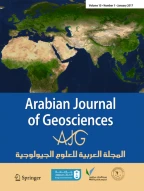Abstract
Although flash floods are one of the major natural disasters that may hamper human development in arid areas, aspects of the process leading to their initiation remain uncertain and poorly understood. In the present study, wadi El-Alam Basin, one of the major basins in the Eastern Desert of Egypt that is frequently subjected to severe flash flood damage, is selected for investigation. Here, a hydrological modeling approach was used to predict flash flood hazard within the basin. Earlier work conducted for the same basin showed that such approach is successful and was able to accurately highlight the locations of historical flood damage. However, such work was based on one set of arbitrary model parameters. The present study has taking into account the rainfall as the excitation factor in the adopted hydrological modeling. The study aims to build on the earlier study by investigating impacts of variation of rainfall depth, areal coverage, and location on flash flood generation. Results demonstrate that the basin under study requires a rainstorm intensity of at least 40 mm in order to initiate surface runoff with a noticeable flood peak at its main outlet. The location of rainstorm has a major effect on the shape of the basin final hydrograph. Furthermore, in the study basin, the upstream flood appears to be of a magnitude and a peak flow that is much higher than those for downstream ones, which believes to be strongly attributed to the surface steepness and impermeability of the former. The used approach shows to be useful in the rapid assessing of flash flood hazard in mountainous desert and could be adopted, with appropriate modifications, elsewhere in arid regions.










Similar content being viewed by others
References
Al-Abed N, Abdulla F, Abu Khyarah A (2005) GIS-hydrological models for managing water resources in the Zarqa River basin. Environ Geol 47:405–411
Blood WH, Humphrey JH (1990) Design cloudburst and flash flood methodology for the western Mojave Desert, California. In: French RH (ed) Hydraulics/hydrology of aridlands (H2AL). American Society of Civil Engineers, Reston, pp 561–566
Chow VT, Maidment DR, Mays LW (1988) Applied hydrology. McGraw-Hill, New York
Costa JE (1987) Hydraulics and basin morphometry of the largest flash floods in the conterminous United States. J Hydrol 93:313–338
El-Etr H, Ashmawy M (1993) Flash flood vulnerability and mitigation of the Red Sea basins between latitudes 24°41′ and 25°26′, Egypt. In: Proceedings of the International Conference 30 Years Cooper, Geological Survey of Egypt, Cairo, pp 335–351
Foody GM, Ghoneim EM, Arnell NW (2004) Predicting locations sensitive to flash flooding in an arid environment. J Hydrol 292:48–58
Gheith H, Sultan M (2002) Construction of a hydrologic model for estimating wadi runoff and groundwater recharge in the Eastern Desert, Egypt. J Hydrol 263:36–55
Ghoneim E (2008) Optimum groundwater locations in the northern Unites Arab Emirates. Int J Remote Sens 29(20):5879–5906
Ghoneim E, El-Baz F (2007) The application of radar topographic data to mapping of a mega-paleodrainage in the eastern Sahara. J Arid Environ 69:658–675
Ghoneim E, Robinson C, El-Baz F (2007) Relics of ancient drainage in the eastern Sahara revealed by Radar Topography data. Int J Remote Sens 28:1759–1772
Greenbaum N, Margalit A, Schick AB, Backer VR (1998) A high magnitude storm and flood in a hyperarid catchment, Nahal Zin, Negev Desert, Israel. Hydrol Process 12:1–23
Grodek T, Lekach J, Schick AP (2000) Urbanizing alluvial fans as flood-conveying and flood-reducing systems: lessons from the October 1997 Eilat flood. In: Hassan M, Slaymaker O, Berkowicz S (eds) The hydrology–geomorphology interface: rainfall, floods, sedimentation, land use. IAHS publication 261. IAHS, Wallingford, pp 229–250
Hammouri N, El-Naqa A (2007) Hydrological modeling of ungauged wadis in arid environments using GIS: a case study of Wadi Madoneh in Jordan. Revista Mexicana de Ciencias Geológicas 24(2):185–196
Jenson SK, Domingue JO (1988) Extracting topographic structure from digital elevation model data for geographic information system analysis. Photogramm Eng Remote Sens 54:1593–1600
Patton PC (1988) Drainage basin morphometry and floods. In: Baker VR, Kochel RC, Patton PC (eds) Flood geomorphology. Wiley, New York, p 503
Patton PC, Baker VR (1976) Morphometry and floods in small basins subject to diverse hydro-geomorphic controls. Water Res Res 12:941–952
Peters JC (1998) HEC-HMS, hydrologic modeling system. US Army Corps of Engineers, Hydrologic Engineering Center, Davis
Philip JR (1957) The theory of infiltration: 4. Sorptivity and algebraic infiltration equations. Soil Sci 84:257–264
Reid I, Laronne JB, Powell MD (1998) Flash-flood and bedload dynamics of desert gravel-bed streams. Hydrol Process 12:543–557
Schick AP, Grodek T, Lekach J (1997) Sediment management and flood protection of desert towns: effect of small catchments. In: Walling DE, Probst JL (eds) Human impact on erosion and sedimentation. IAHS publication 245. IAHS, Wallingford, pp 183–189
SCS (1985) National engineering handbook. US Department Agriculture, Soil Conservation Service, Washington, DC
Sharon D (1972) The spottiness of rainfall in a desert area. J Hydrol 17:161–175
Sorman AU, Abdulrazzak MJ, Elhames AS (1990) Rainfall–runoff modeling of a microcatchments in the western region of Saudi Arabia. In: Lang H, Musy A (eds) Hydrology in mountainous regions: hydrological measurements, the water cycle. IAHS publication 193. IAHS, Wallingford, pp 655–659
Tso B, Mather PM (2001) Classification methods for remotely sensed data. Taylor and Francis, London
Zeller ME (1990) Precipitation on arid or semiarid regions of the southwestern United States: research needs from a consultant’s perspective. In: French RH (ed) Hydraulics/hydrology of arid lands (H2AL). American Society of Civil Engineers, Reston, pp 525–529
Acknowledgments
The authors are greatly thankful to Nigel Arnell, Director of Walker Institute for Climate System Research, University of Reading, UK, for his comprehensive review and very useful comments.
Author information
Authors and Affiliations
Corresponding author
Rights and permissions
About this article
Cite this article
Ghoneim, E., Foody, G.M. Assessing flash flood hazard in an arid mountainous region. Arab J Geosci 6, 1191–1202 (2013). https://doi.org/10.1007/s12517-011-0411-7
Received:
Accepted:
Published:
Issue Date:
DOI: https://doi.org/10.1007/s12517-011-0411-7


